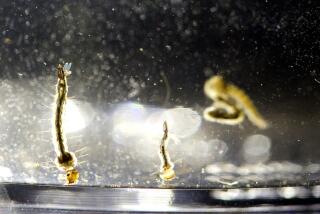Biotech Firm Left to Own Devices : Funds to Help Biosite Put Toxin Gadgets on Market
- Share via
Just over a year ago , Kim Blickenstaff had what many would consider an ideal job, playing a principal management role at booming Hybritech Inc. , one of San Diego’s most successful biotechnology firms.
But for Blickenstaff, who held various Hybritech jobs , including marketing director and regional sales manager, there was trouble in paradise.
“Things at Hybritech had been played out,” he said. “We were spending more of our time supporting current products, rather than working on developing new product groups.
“We wanted to be creative again. We wanted our own company.”
Today, both creativity and money are flowing at Biosite Diagnostics, the biotechnology start-up launched last year by Blickenstaff and three other Hybritech defectors.
Last week, the fledgling company announced it had secured $3 million in equity financing from several leading venture capital firms. Biosite’s $600,000 in seed money was supplied in April, 1988, by Biovest Partners, a San Diego-based venture capital firm. Biosite hopes to have its first product on the market by 1991.
It plans to use the funds for the technical development of the company’s first line of products: simple-to-use, small medical diagnostic devices that can rapidly detect drugs or industrial toxins in samples.
Some of the initial applications of Biosite’s proprietary technology could be used to test for drug abuse. For instance, in a hospital emergency room, a doctor could use the device to quickly determine the type of overdose an unconscious victim is suffering from. The technology could also be used to monitor prescribed drugs that are being administered to a patient.
“It has the potential to create a whole new market,” Blickenstaff said. “Right now, this type of testing is done on large pieces of equipment that require trained technicians to use them. And your use of them is limited because they’re only available at labs. Our devices can be used anywhere, and they will be able to provide equivalent, if not superior, readings.”
According to Dr. Gunars Valkirs, Biosite’s chief technical officer, the proposed device uses the immunoassay method, which employs specific monoclonal antibodies, to detect certain substances, such as drugs or industrial toxins.
Through the binding of the antibodies to the substance that is being tested, Biosite’s device can detect even low concentrations of the tested material. In addition, company officials say, the proposed device can test for several substances at once.
“The difference their product would bring is that you could read them very fast and you don’t need the instruments,” said Cole Owen, senior vice president of Fritzsche, Pambianchi & Associates, a Del Mar-based health care consulting firm.
Biosite officials say the device will include “discrete zones” for each of the substances being tested. When a substance is detected, a color visual readout appears in its respective zone within five minutes, officials say.
“The physician can get the results” quickly, Owen said. “It would bring new flexibility and speed to obtaining these results.”
If successful in its venture, industry analysts say, Biosite can capture a lucrative market. According to Owen, the company’s initial products are targeting combined drugs of abuse and therapeutic drug monitoring markets of $350 million annually in the United States.
“The (equity financing) amount should get us through the technical development of our project,” Blickenstaff said. “And then we’re planning to get another $3 million for manufacturing and marketing.”
The big-name venture capital firms sponsoring Biosite, industry analysts say, is also a good sign for the company.
“Let’s just say their backers have picked plenty of winners before,” Owen said. The principal investors are Biovest Partners, Medicus Ventures, Euclid Partners and Kleiner Perkins Caufield & Byers. Kleiner Perkins, for example, was one of the first investors of Hybritech and Genentech, both successful biotechnology firms.
Guiding a product from concept to market is a tricky process, but, according to analysts, Biosite has made all the right moves so far.
“They have a rather promising technology,” said Harris Kaplan, executive vice president at Migliara/Kaplan Associates, a Maryland-based medical marketing research firm. “If they can deliver the technology, they should do very well in the marketplace. It’s clear that this market has attracted a number of companies, but I think Biosite has a product that appears to be unique.”
Industry analysts have also praised Biosite’s prudent ways.
“The founders appear to have devoted the majority of their funding to date toward product development as it should be spent,” Owen said. “They’ve wisely spent money on product development, not on executive offices. The company certainly appears to have made strong progress in its research and development on a relatively small amount of seed money.”
The seed capital was provided by Biovest, whose general partners are Ted Greene, former founder and chief executive officer of Hybritech, and Tim Wollaeger, former Hybritech senior vice president and chief executive officer. Wollaeger is also serving as Biosite’s chairman.
“It was scary leaving. . . . The first six months we were trying to figure out what we were doing,” Blickenstaff said. “We didn’t have a product or a technology. We had nothing. But our founders had faith in us that if they put a problem before us to solve, that we would come up with something.”
That’s exactly what Biosite’s core group did.
The drive behind Biosite’s diagnostic tool was led by Valkirs, the company’s chief technical officer. Valkirs was the inventor of Hybritech’s ICON technology, which was used in the company’s pregnancy tests, one of its most successful product lines.
The rest of Biosite’s core group consists of Dr. Richard Anderson, director of product development, and Dr. Kenneth Buechler, director of chemistry.
The core group, using the ICON technology, successfully developed a series of diagnostic equipment, including for pregnancy testing and detection of heart attacks and infectious diseases.
Although their medical diagnostic device has yet to hit the market, Biosite officials have already started making grand plans.
“Our technology would be perfect for the over-the-counter and home-use markets,” Blickenstaff said. “We’ve been talking with several major firms. . . . It’s an avenue that we’re definitely looking at.”
Since its start with four Hybritech defectors, Biosite has increased its staff to 16 employees. The company plans to double the work force by the end of 1990. It now leases 3,500 square feet of laboratory space at the General Atomics complex, and, by the end of the year, would like to lease 6,000 square feet in Sorrento Valley for manufacturing and product development, Blickenstaff said.






